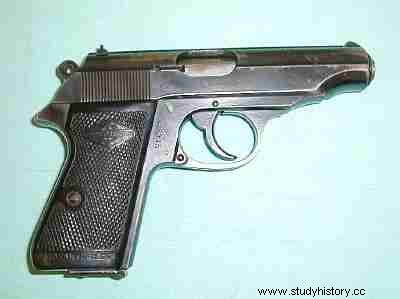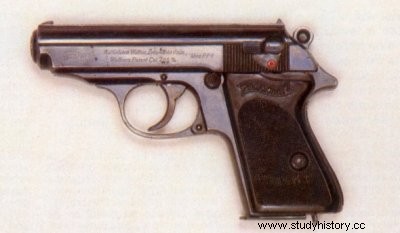Walther PP (varies by caliber)
* Length:17.3cm
* Barrel length:9.9cm
* Unladen weight:0.682kg
* Loaded weight:0.809kg
* Capacity:10 rounds 22LR, PP Sport model, 8 rounds (22LR, 6.35mm and 7.65 Browning) and 7 rounds (9mm short)

Walther PPK (varies by caliber)
* Length:15.4cm
* Barrel length:8.4cm
* Unloaded weight:0.568kg
* Loaded weight:0.790kg
* Capacity:7 shots (22 LR, 6.35mm and 7.65 Browning) and 6 shots (9mm short)

The Walther PP (Polizei Pistole) is a German pistol put into production in 1929. It met with rapid success with the European police and was declined in 1931 in a compact version called Walther PPK (Polizei Pistole Kriminal) equipped with a frame made of Duralumin, a light alloy.
This weapon was immortalized by the famous secret agent James Bond, imagined by Ian Fleming. We thus see appearing in the James Bond films 007 against Dr. No until GoldenEye, after which the character uses a Walther P99.
In addition to its small size, the Walther PP was the first double action pistol to meet with real success. Its simple mechanism operated directly by recoil can only use low-powered ammunition. PP and PPK are traditionally chambered in 7.65 Browning (32 ACP) and 9mm short (380 ACP). There are versions firing the .22 Long Rifle and, more rarely, the caliber 6.35mm (.25 ACP).
In addition, the Walther PP and PPK are characterized by the use of a particularly innovative and effective safety device neutralizing the hammer and the firing pin. In addition, it is possible to determine by touch if a cartridge is already present in the chamber, by a witness (kind of pin) protruding from the back of the slide. Such a mechanism is very useful for a "pocket" weapon whose primary purpose, according to the mores of the 1930s, is defense.
Like the majority of handguns then available, these weapons will be used by the German army during the Second World War. After 1945, the PP and PPK remained in the holsters of German police officers until the appearance of the Walther P5, Sig-Sauer P6 (official name of the Sig-Sauer P225 in Germany and Switzerland) and the HK P7.
Production continued after the war with the granting of licenses abroad (including France with the Manufacture de Machine du Haut Rhin, better known as Manurhin, between 1955 and 1989). The Walther-Manurhin PP/PPK equipped the National Police and the French Customs in the 1960s and 1970s before the arrival of the MR-73. The Interarms firm (Alexandria, Virginia), North American importer of Walther, created in the 1970s the PPK/Spécial (PPK/S) combining the frame of the PP caliber 9mm Court and the barrel/slide assembly of the PPK. This weapon built in stainless steel, very popular in the United States, improves the grip of the PPK while sparing its compactness. In the 1990s, Walther produced a carbon steel version for European markets:the PPK/E
Turkey (MKE Kirrikale), Argentina (Bersa) and Hungary (FÉG) still produced or built derivatives of the PP more or less derived from the original.
